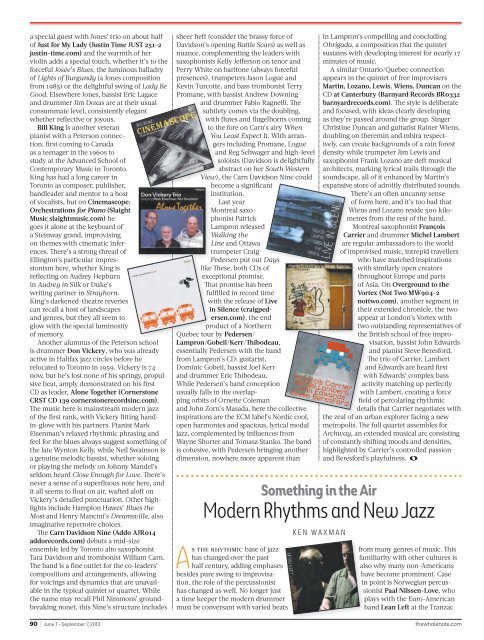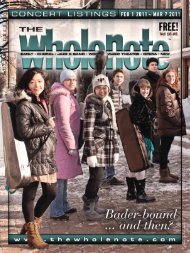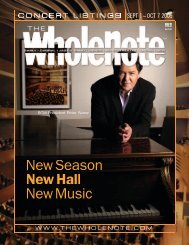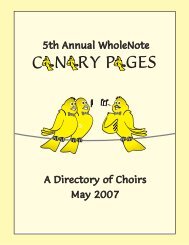a special guest with Jones’ trio on about halfof Just for My Lady (Justin Time JUST 251-2justin-time.com) and the warmth of herviolin adds a special touch, whether it’s to theforceful Josée’s Blues, the luminous balladryof Lights of Burgundy (a Jones compositionfrom 1985) or the delightful swing of Lady BeGood. Elsewhere Jones, bassist Eric Lagaceand drummer Jim Doxas are at their usualconsummate level, consistently elegantwhether reflective or joyous.Bill King is another veteranpianist with a Peterson connection,first coming to Canadaas a teenager in the 1960s tostudy at the Advanced School ofContemporary Music in Toronto.King has had a long career inToronto as composer, publisher,bandleader and mentor to a hostof vocalists, but on Cinemascope:Orchestrations for Piano (SlaightMusic slaightmusic.com) hegoes it alone at the keyboard ofa Steinway grand, improvisingon themes with cinematic inferences.<strong>The</strong>re’s a strong thread ofEllington’s particular impressionismhere, whether King isreflecting on Audrey Hepburnin Audrey in Silk or Duke’swriting partner in Strayhorn.King’s darkened-theatre reveriescan recall a host of landscapesand genres, but they all seem toglow with the special luminosityof memory.Another alumnus of the Peterson schoolis drummer Don Vickery, who was alreadyactive in Halifax jazz circles before herelocated to Toronto in 1959. Vickery is 74now, but he’s lost none of his springy, propulsivebeat, amply demonstrated on his firstCD as leader, Alone Together (CornerstoneCRST CD 139 cornerstonerecordsinc.com).<strong>The</strong> music here is mainstream modern jazzof the first rank, with Vickery fitting handin-glovewith his partners. Pianist MarkEisenman’s relaxed rhythmic phrasing andfeel for the blues always suggest something ofthe late Wynton Kelly, while Neil Swainson isa genuine melodic bassist, whether soloingor playing the melody on Johnny Mandel’sseldom heard Close Enough for Love. <strong>The</strong>re’snever a sense of a superfluous note here, andit all seems to float on air, wafted aloft onVickery’s detailed punctuation. Other highlightsinclude Hampton Hawes’ Blues theMost and Henry Mancini’s Dreamsville, alsoimaginative repertoire choices.<strong>The</strong> Carn Davidson Nine (Addo AJR014addorecords.com) debuts a mid-sizeensemble led by Toronto alto saxophonistTara Davidson and trombonist William Carn.<strong>The</strong> band is a fine outlet for the co-leaders’compositions and arrangements, allowingfor voicings and dynamics that are unavailablein the typical quintet or quartet. Whilethe name may recall Phil Nimmons’ groundbreakingnonet, this Nine’s structure includessheer heft (consider the brassy force ofDavidson’s opening Battle Scars) as well asnuance, complementing the leaders withsaxophonists Kelly Jefferson on tenor andPerry White on baritone (always forcefulpresences), trumpeters Jason Logue andKevin Turcotte, and bass trombonist TerryPromane, with bassist Andrew Downingand drummer Fabio Ragnelli. <strong>The</strong>subtlety comes via the doubling,with flutes and flugelhorns comingto the fore on Carn’s airy WhenYou Least Expect It. With arrangersincluding Promane, Logueand Reg Schwager and high-levelsoloists (Davidson is delightfullyabstract on her South WesternView), the Carn Davidson Nine couldbecome a significantinstitution.Last yearMontreal saxophonistPatrickLampron releasedWalking theLine and Ottawatrumpeter CraigPedersen put out Dayslike <strong>The</strong>se, both CDs ofexceptional promise.That promise has beenfulfilled in record timewith the release of Livein Silence (craigpedersen.com),the endproduct of a NorthernQuebec tour by Pedersen/Lampron/Gobeil/Kerr/Thibodeau,essentially Pedersen with the bandfrom Lampron’s CD: guitarist,Dominic Gobeil, bassist Joel Kerrand drummer Eric Thibodeau.While Pedersen’s band conceptionusually falls in the overlappingorbits of Ornette Colemanand John Zorn’s Masada, here the collectiveinspirations are the ECM label’s Nordic cool,open harmonies and spacious, lyrical modaljazz, complemented by influences fromWayne Shorter and Tomasz Stanko. <strong>The</strong> bandis cohesive, with Pedersen bringing anotherdimension, nowhere more apparent thanin Lampron’s compelling and concludingObrigada, a composition that the quintetsustains with developing interest for nearly 17minutes of music.A similar Ontario/Quebec connectionappears in the quintet of free improvisersMartin, Lozano, Lewis, Wiens, Duncan on theCD at Canterbury (Barnyard Records BR0332barnyardrecords.com). <strong>The</strong> style is deliberateand focused, with ideas clearly developingas they’re passed around the group. SingerChristine Duncan and guitarist Rainer Wiens,doubling on theremin and mbira respectively,can create backgrounds of a rain forestdensity while trumpeter Jim Lewis andsaxophonist Frank Lozano are deft musicalarchitects, marking lyrical trails through thesoundscape, all of it enhanced by Martin’sexpansive store of adroitly distributed sounds.<strong>The</strong>re’s an often uncanny senseof form here, and it’s too bad thatWiens and Lozano reside 500 kilometresfrom the rest of the band.Montreal saxophonist FrançoisCarrier and drummer Michel Lambertare regular ambassadors to the worldof improvised music, intrepid travellerswho have matched inspirationswith similarly open creatorsthroughout Europe and partsof Asia. On Overground to theVortex (Not Two MW904-2nottwo.com), another segment intheir extended chronicle, the twoappear at London’s Vortex withtwo outstanding representatives ofthe British school of free improvisation,bassist John Edwardsand pianist Steve Beresford.<strong>The</strong> trio of Carrier, Lambertand Edwards are heard firstwith Edwards’ complex bassactivity matching up perfectlywith Lambert, creating a forcefield of percolating rhythmicdetails that Carrier negotiates withthe zeal of an urban explorer facing a newmetropolis. <strong>The</strong> full quartet assembles forArchway, an extended musical arc consistingof constantly shifting moods and densities,highlighted by Carrier’s controlled passionand Beresford’s playfulness.Something in the AirModern Rhythms and New JazzAs the rhythmic base of jazzhas changed over the pasthalf century, adding emphasesbesides pure swing to improvisation,the role of the percussionisthas changed as well. No longer justa time keeper the modern drummermust be conversant with varied beatsKEN WAXMANfrom many genres of music. Thisfamiliarity with other cultures isalso why many non-Americanshave become prominent. Casein point is Norwegian percussionistPaal Nilssen-Love, whoplays with the Euro-Americanband Lean Left at the Tranzac90 | June 7 – September 7, 2013 thewholenote.com
on June 15. Nilssen-Love, whoseassociates range from the mostcommitted electronics dialtwisterto free-form veterans isequally proficient laying downa hard rock-like beat as he istrading accents with experimentaltimbre-shatters.<strong>The</strong> two extended tracks onLive at Café Oto (Unsounds 32Uunsounds.com) demonstrate notonly Nilssen-Love’s cohesive skillsamplifying the improvisations ofChicago-based tenor saxophonist/clarinettist Ken Vandermark ashe does in many other contexts,but shows how both react tothe power chords and violentstring distortions which characterizethe style of guitarists Andy Moorand Terrie Ex from Dutch punk band <strong>The</strong>Ex, who complete this quartet. In spite ofVandermark’s consistent overblowing whichencompasses pumping altissimo honks andfrenetic slurs, plus the guitarists’ constantcrunches, smashes and frails, the drummingnever degenerates into monotonousPOT POURRIEmbraceLenka Lichtenberg with FraySunflower RecordsBridges – Live at Lula LoungeLenka Lichtenberg and Roula SaidSR CD 005Songs for the Breathing WallsLenka Lichtenberglenkalichtenberg.com!!Fray (Free), the Czech born Torontobasedsinger-songwriter Lenka Lichtenberg’sbreakout 2011 album, embraced the city’sworld music aesthetic and its musicians.Embrace, her outstanding new production,continues to explore and expand that artisticdirection.<strong>The</strong> title lyric of the Lichtenberg songPeace Is the Only Way is a central theme ofEmbrace. Its refrain is the personal mottoof the Israeli violinist, oud player, songwriterand peace activist Yair Dalal. A leadingmusician on the global world music scenehis ideals and spirit, bridging Arabic andIsraeli — and other — divides, permeates thisalbum. <strong>The</strong> spirit of peaceful coexistenceamong loss and struggle is also present aswell in the earlier CDs, the live-off-the-floorrock music-like banging. Instead, while thebackbeat isn’t neglected, auxiliaryclips, ruffs, ratamacues andsmacks are used by Nilssen-Loveto break up the rhythm, with carefullymeasured pulsations. Thisstrategy is most obvious during theclimatic sections of the more-than-37-minute Drevel. With all four LeanLefters improvising in broken octaves,the narrative shakes to and frobetween Vandermark’s collectionof emphasized freak notesand dyspeptic stridency and thedual guitarists’ slurred fingeringthat leads to staccato twangs andjangling strums. Not only is theclimax attained with a crescendoof volume and excitement, but thefinal theme variations are in contrast as starkand minimalist as the earlier ones are noisy.As guitars methodically clank as if reading apost-modern composition, and the clarinetlines emphasize atonal reed bites, intermittentstick strokes and toe-pedal pressure fromthe drummer concentrate the sound shardsinto the track’s calm finale.Read how the drummer and reedist improvise alongside Ab Baars,another talented multi-reedist; how Vandermark scores with amixed European-American large ensemble; as well as how saxophonistMats Gustafsson, a close associate of both men, ralliesthe excitement of an even larger band with four drummers in thecontinuation of this column at thewholenote.com.Bridges: Live at LulaLounge and the Songsfor the BreathingWalls recorded on sitein the Czech Republic.<strong>The</strong> main directionson Embrace are multifold:world musicblendings, songs inthe Yiddish theatricaltradition, klezmerinstrumental touchesand Jewish liturgy. It’sall skillfully linkedby Lichtenberg’seffective song writingand unaffectedvocals, as well as veryeffective yet unfussy,lush-sounding, instrumentation.Yair Dalalshares co-compositioncredits withLichtenberg on theatmospheric trackPerfume Road whichbegins with an environmental recording ofbirds outside the recording studio backingDalal’s free-metre Middle Eastern-inflectedoud introduction, segueing seamlessly toLichtenberg’s crystalline singing of her ownYiddish lyrics. Also to savour: the superbperformances by Lichtenberg’s band, Fray,and guest musicians comprising Toronto’sworld music and jazz scene A-listers, as wellas those from beyond the GTA. Album guestsinclude the well-known Hindustani sarangiplayer Druba Ghosh, violinist Hugh Marshand Kevin Turcotte on trumpet.Some of the same material is assayed inLichtenberg and Roula Said’s 2012 releaseBridges, with many of the same musicians.<strong>The</strong> major difference here is Said’s authoritativeArabic language vocal contributionsand the inclusion of songs in the Arabiclineage. I moreover enjoyed the freedom andstraightforward arrangements in this liveconcert recorded at Toronto’s Lula Lounge, ascompared with the tightly sculpted Embracestudio magic. This contrast is particularlyclear in the extended open-feel instrumentalsolos in Bridges, giving the virtuosomusicians a change to groove and expressthemselves.<strong>The</strong> deeply affecting album Songs for theBreathing Walls refers to the 12 historicsynagogues scattered throughout theCzech Republic whose Jewish populationswere decimated by the Holocaust. <strong>The</strong>sesettings of Jewish liturgical songs reflectthe varying onsite interior acoustics of thesynagogues, their outside soundscapes (ontrack 18 Lichtenberg remarks “ ... birds, cars,bells ... everything ... ”) as well as their history,intimately connected to their congregations.For instance, accompanied by a sole violin,El Maley Rachamim was recorded in a synagoguehidden within the <strong>The</strong>resienstadtconcentration camp. <strong>The</strong> personal connectionsare palpable in her voice: this is theplace Lichtenberg’s mother and grandmotherswere interned during the SecondWorld War. <strong>The</strong> exemplary liner notes withtranslations of the lyrics, photos of thesynagogues and notes about their historyadd immensely to savouring this musicalexperience. It’s an achievement for whichLichtenberg was honoured as TraditionalSinger of the Year at the November 2012Canadian Folk Music Awards.—Andrew TimarFEELING LUCKY?THREE WAYS TO WINCDs, tickets and othermusical prizes courtesy of<strong>The</strong> WholeNote1. join our mailing list byregistering atthewholenote.com2. Like us on Facebook3. Follow us on Twitterthewholenote.comthewholenote.com June 7 – September 7, 2013 | 91
- Page 1 and 2:
FREE!Vol 18 No 9CONCERT LISTINGS |
- Page 5 and 6:
Top 500 CEO's and their .COM Domain
- Page 9:
Institute and performances of Hande
- Page 13 and 14:
Joe Macerollo.Starting off in June,
- Page 15 and 16:
Beat by Beat | World ViewA Slow Hot
- Page 17 and 18:
Beat by Beat | Classical & BeyondSt
- Page 19 and 20:
116 13T H SEASON14MUSIC IN THEAFT E
- Page 21 and 22:
Musicat MetropolitanMusic at Metrop
- Page 23 and 24:
in harmony with the aesthetic of th
- Page 25 and 26:
Beat by Beat | Art of SongThe Songs
- Page 27 and 28:
For operas in concert in June, one
- Page 29 and 30:
acheal mccaigdirector of the Shaw F
- Page 31 and 32:
jack macquarrieLeading Seaman James
- Page 33 and 34:
is that the best jazz I’ve heard
- Page 35 and 36:
A toast to jams: Between the Festiv
- Page 37 and 38:
416-593-0688(Chinese). $29-$120. Al
- Page 39 and 40: ●●7:30: Domoney Artists Managem
- Page 41 and 42: Lula Lounge June 19, 8pmTD Toronto
- Page 43 and 44: College, 540 Lakeshore Rd. W., Oakv
- Page 46 and 47: $12.50(child). Also Aug 9, 10 and 1
- Page 48 and 49: at modest cost.●●2:30: Seniors
- Page 50 and 51: ●●7:30: Brookside Music Summer
- Page 52 and 53: pubaret.com (full schedule)Jun 7 7p
- Page 54 and 55: GALAS & FUNDRAISERS●●Jun 2, 3:0
- Page 56 and 57: ●●Jun 29, 5:00: Canadian Flute
- Page 58 and 59: through different acoustic spaces o
- Page 60 and 61: Classified Advertising | classad@th
- Page 62 and 63: GREEN PAGESSUMMER MUSIC GUIDEWelcom
- Page 64 and 65: GREEN PAGESthe tutelage of some of
- Page 66 and 67: GREEN PAGESin which he will project
- Page 68 and 69: 5 Senses FestivalAugust 16 and 17Ri
- Page 70 and 71: Glick: The Hour Has Come; Halley: S
- Page 72 and 73: fiddles; Ten Strings And A Goat Ski
- Page 74 and 75: Castlereagh StreetRVE - Ravine Vine
- Page 76 and 77: and Afrocuban. ACS; 1:00: Donna Gre
- Page 78 and 79: Celebration of world cultures featu
- Page 80 and 81: FESTIVAL DIGESTVisit thewholenote.c
- Page 82 and 83: DISCOVERIES | RECORDINGS REVIEWEDIw
- Page 84 and 85: drunken soldier), his voice perfect
- Page 86 and 87: work is a large and lush canvas wit
- Page 88 and 89: thought about the orchestra or the
- Page 92: Old Wine, New Bottles | Fine Old Re
- Page 96: Paris La Belle ´ EpoqueJULY 16-AUG
















